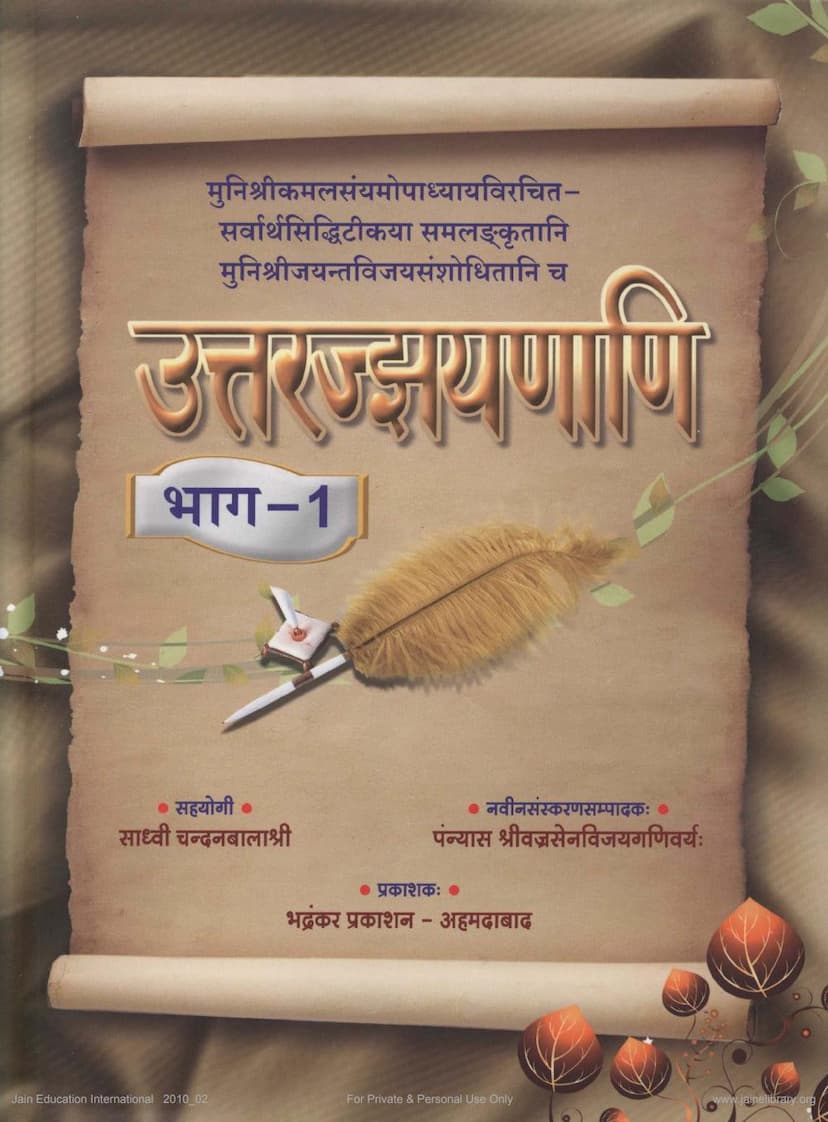Agam 43 Mool 04 Uttaradhyayan Sutra Part 01
Added to library: September 1, 2025

Summary
Here's a comprehensive summary of the Jain text "Agam 43 Mool 04 Uttaradhyayan Sutra Part 01," based on the provided pages:
Overall Context:
This text, "Agam 43 Mool 04 Uttaradhyayan Sutra Part 01," is the first part of the Uttaradhyayan Sutra, a foundational Jain scripture. It is presented with the "Sarvarthasiddhi" commentary by Upadhyay Shri Kamalsanyamvijay, revised by Muni Shri Jayantvijay, and edited for this new edition by Panyas Shri Vajrasenvijay. The publisher is Bhadrankar Prakashan, Ahmedabad, with the edition dated 2010.
Key Themes and Structure:
The provided pages cover the initial chapters (Adhyayanas 1-16) of the Uttaradhyayan Sutra, focusing on fundamental Jain principles and the path of a renunciate (monk or nun). The text emphasizes:
- The Importance of Vinaya (Humility and Discipline): The first Adhyayana, "Vinaya Adhyayan," stresses the paramount importance of humility, discipline, and obedience to the guru and scriptures. It contrasts the characteristics of a virtuous disciple (Vinita) with a wicked one (Avinita) through illustrative stories and proverbs.
- Endurance of Hardships (Parishaha): The second Adhyayana, "Parishaha Adhyayan," details the twenty-two types of hardships that ascetics must face and overcome with equanimity. It uses the examples of various saints and their struggles to illustrate the path of spiritual endurance.
- The Rarity of Human Birth and Spiritual Opportunity: The third Adhyayana, "Chaturangeeya Adhyayan," highlights the extreme rarity of human birth, the acquisition of virtuous qualities, faith, and the strength for asceticism. It underscores the preciousness of this life for spiritual progress.
- The Impermanence of Life and the Dangers of Negligence: The fourth Adhyayana, "Asamskrit Adhyayan," emphasizes the impermanent nature of life, the inevitability of aging and death, and the futility of attachment to worldly possessions. It warns against negligence in spiritual pursuits.
- The Nature of Death and the Importance of Righteous Death (Pandit Maran): The fifth Adhyayana, "Akama Maran," discusses the different types of death, differentiating between unintentional (Akama) and intentional (Pandit) death. It stresses the importance of dying with equanimity and spiritual awareness.
- The Path of a Pure Ascetic (Nirgranth): The sixth Adhyayana, "Kshullak Nirgranthiya," delves into the characteristics of a pure renunciate (Nirgranth), emphasizing detachment from desires, non-violence, and the practice of the Jain path. It contrasts this with the pitfalls of ignorance and attachment.
- The Dangers of Sensual Pleasures (Aulbariya and Kapiliya/Nami Pravrajya): The seventh, eighth, and ninth Adhyayanas (Aurabriya, Kapiliya, and Nami Pravrajya) use stories to illustrate the dangers of attachment to sensual pleasures, greed, and the importance of detachment. They highlight how clinging to these leads to suffering and rebirths. The story of King Nami and his renunciation is central to the ninth chapter.
- The Value of Knowledge and Right Conduct (Dravya Patraka and Bahushruta Puja): Chapters ten, eleven, and twelve (Dravya Patraka, Bahushruta Puja, and Harikeshiya) discuss the importance of right conduct and the spiritual benefits derived from associating with and serving knowledgeable and virtuous beings (Bahushruta). They also touch upon the concept of self-discipline and the rarity of true spiritual attainment.
- The Pursuit of True Happiness and Detachment: The subsequent chapters, including the thirteenth ("Chitra Sambutiya"), fourteenth ("Ishukariya"), and fifteenth ("Sabhikshuka"), continue to elaborate on the spiritual path, emphasizing detachment from worldly attachments, the avoidance of negative predispositions (like Nidana – making vows with desires for specific worldly outcomes), and the virtues of a mendicant (Bhikshu).
- Brahmacharya and Samadhi: The sixteenth Adhyayana, "Brahmacharya Samadhi Sthana," focuses on the practice of Brahmacharya (celibacy and spiritual discipline) and the attainment of Samadhi (deep meditation and mental control) as crucial elements for spiritual progress.
Commentary and Editorial Approach:
The commentary "Sarvarthasiddhi" is described as simple, easy to understand, and full of profound meaning. It explains the original verses with cultural context, mythological stories, and philosophical insights. The edition includes citations from various texts and historical references to previous publications. The editors and publishers express gratitude to individuals and organizations who contributed to the publication.
Overall Message:
The Uttaradhyayan Sutra, as presented in this first part, is a comprehensive guide for spiritual seekers. It emphasizes self-control, detachment, non-violence, humility, knowledge, and the relentless pursuit of liberation (Moksha) through righteous conduct, even in the face of worldly temptations and hardships. The text uses narratives and teachings from the lives of saints, kings, and ascetics to illustrate these core Jain principles.